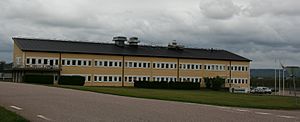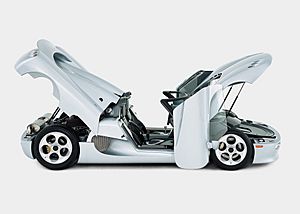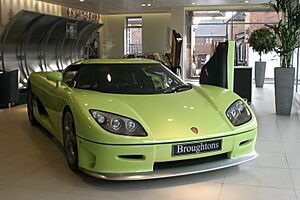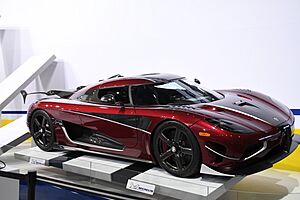Koenigsegg facts for kids
 |
|
| Aktiebolag | |
| Industry | Automotive |
| Founded | 1994 |
| Founder | Christian von Koenigsegg |
| Headquarters |
,
Scania, Sweden
|
|
Area served
|
Worldwide |
|
Key people
|
|
| Products |
|
| Owner | Christian von Koenigsegg |
Koenigsegg Automotive AB is a Swedish company that makes super-fast sports cars. Their main base is in Ängelholm, Sweden.
Koenigsegg cars have often broken speed records for production cars. This means they are some of the fastest cars ever made that you can buy.
Contents
About Koenigsegg Cars
The company started in 1994 in Sweden. It was founded by Christian von Koenigsegg. His dream was to build a "world-class" sports car.
Many years of hard work and testing led to their first car. This was the Koenigsegg CC8S, which was allowed on public roads. It was shown to the world in 2002.
Developing New Models
In 2006, Koenigsegg began making the Koenigsegg CCX. This car had an engine made especially for it by Koenigsegg. The goal was to make a car that could be sold all over the world. This included the United States, which has very strict car rules. Earlier Koenigsegg cars could not be sold there.
The CCXR was named one of "the world's most beautiful cars" by Forbes magazine in 2009. In 2010, the Koenigsegg Agera won the "Hypercar of the Year Award" from BBC Top Gear.
Beyond Sports Cars
Koenigsegg also works on "green technology." This started with the CCXR "Flower Power" car. This car could run on special plant-based fuel. They also work on electric car systems. They even developed a special engine without camshafts. This engine was first used in the Koenigsegg Gemera, which came out in 2020.
Koenigsegg makes most of its car parts and systems itself. They do not rely much on other companies. This is unusual for a small car maker.
In 2019, Koenigsegg sold a small part of its company to another Swedish car maker, National Electric Vehicle Sweden (NEVS). But by 2021, Koenigsegg bought back that part and now owns 100% of the company again.
In 2023, Koenigsegg opened a new factory and research center in Ängelholm. This helped them make more cars. By the end of 2023, Koenigsegg had almost 800 employees.
Koenigsegg's History
How the Factory Started

Christian von Koenigsegg got the idea to build cars when he was young. He watched a movie called The Pinchcliffe Grand Prix. When he was 22, he found investors and started Koenigsegg Automotive in 1994.
The company first started in Olofström. In the early 2000s, it moved to Ängelholm. In 2003, a fire damaged one of their buildings. Koenigsegg then bought an old air field. They turned a large airplane hangar and an office building into a car factory.
The company is still near the Ängelholm airport. Koenigsegg uses the old military runway to test their cars. They do high-speed runs there. In July 2023, Koenigsegg opened a new factory near the old one. This doubled their ability to make cars.
Early Car Designs
Christian von Koenigsegg drew the first design for the Koenigsegg CC. A designer named David Crafoord helped turn these drawings into a small model. This model was then used to create the first full-size prototype car in 1996. Over the next few years, many tests were done, and new prototypes were built.
At first, the prototypes used an Audi engine. Later, Koenigsegg started making its own engines from scratch. They also developed their own control systems and gearboxes. This is very rare for a small sports car company.
The Koenigsegg Badge
The Koenigsegg badge was designed in 1994 by Jacob Låftman. It is based on the family crest of the von Koenigsegg family. This shield has been their family symbol since the 12th century.
The Ghost Symbol
When Koenigsegg moved to the old airfield, they adopted a "ghost symbol." This symbol was used by the Swedish Air Force squadron that used to be there. It is a tribute to the squadron. You can see this badge on cars built in the factory that was once a hangar.
Koenigsegg Car Models
The first Koenigsegg CC prototype was shown in 1996. The first production car, the Koenigsegg CC8S, was shown at the 2000 Paris Motor Show. The first customer received a red CC8S in 2002.
In 2004, the Koenigsegg CCR was shown. This was a faster version of the CC8S. Only 14 of these were made.
Meeting Global Standards
In 2006, Koenigsegg introduced the Koenigsegg CCX. This model was made to meet car rules all over the world. This meant the car had to go through many tests. It had to meet the newest safety and pollution rules. Koenigsegg even had to make its own engines for this car.
In 2007, the CCXR was shown. This car could use a special fuel called biofuel. It had a changed engine and fuel system. This allowed it to run on regular gasoline or ethanol, or a mix of both. Ethanol helps the car perform better.
In 2009, Koenigsegg shared details about a special car called the Koenigsegg Trevita. Only two of these were made. The Trevita means "three whites" in Swedish. Its body is made of a special carbon fiber that looks like it's covered in diamonds.
The Agera and Regera
In 2010, Koenigsegg showed a new model called the Koenigsegg Agera. "Agera" means "to take action" in Swedish. The Agera had a powerful 5.0-liter V8 engine. It also had a new 7-speed gearbox. The Agera looked like earlier Koenigsegg cars but had new features. One cool feature was "Ghost Light" inside. This lighting was hidden until turned on. Production of the Agera ended in 2018.
At the 2015 Geneva Motor Show, Koenigsegg showed the Koenigsegg Regera. "Regera" means "to reign" or "to rule." This car uses a special system called Koenigsegg Direct Drive (KDD). It has electric motors and a powerful engine. It does not have a traditional gearbox.
The Jesko and Gemera
In 2019, Koenigsegg showed the Koenigsegg Jesko. This car was named after Christian von Koenigsegg's father, Jesko. The Jesko uses an improved 5.0-liter V8 engine. It can make even more power when using E85 biofuel. It has a special 9-speed gearbox called "Light Speed Transmission." This gearbox helps the car shift gears very quickly. Buyers can choose a Jesko for track racing or a super-fast version for top speed.
On March 3, 2020, the Koenigsegg Gemera was shown. This is Koenigsegg's first car with four seats. Only 300 of these cars will be made. It uses a small but powerful engine called the "Tiny Friendly Giant" (TFG). The car also has unique doors that open in a special way.
List of Koenigsegg Models
| Model | Year | Units | 0–100 km/h (0–62 mph) | Top Speed | Notes and References |
|---|---|---|---|---|---|
| CC | 1994 | 1 | Prototype. | ||
| CC8S | 2002–2003 | 6 | 3.5 sec | 390 km/h (240 mph) | 2 right hand drive. |
| CCR | 2004–2006 | 14 | 3.2 sec | 395 km/h (245 mph) (claimed), 387.866 km/h (241.009 mph) (tested) | |
| CCX | 2006–2010 | 29 | 3.2 sec | 395 km/h (245 mph) (claimed) | |
| CCGT | 2007 | 1 | Made for racing in the FIA GT1. | ||
| CCXR | 2007–2009 | 9 | 3.1 sec | 401 km/h (249 mph) (claimed) | |
| CCX Edition | 2008 | 2 | 3.0 sec | 401 km/h (249 mph) (claimed) | |
| CCXR Edition | 2008 | 4 | 2.9 sec | 401 km/h (249 mph) (claimed) | |
| CCXR Special Edition | 2008–2009 | 2 | 2.9 sec | 401 km/h (249 mph) (claimed) | |
| Trevita | 2008–2009 | 2 | 2.9 sec | 410 km/h (250 mph) (claimed) | |
| Quant | 2009 | Solar Concept Car. | |||
| Agera | 2010 | 7 | 3.0 sec | 420 km/h (260 mph) (claimed) | 2 later became Agera R. |
| Agera R | 2011–2014 | 18 | 2.8 sec, 0–200 km/h (0–124 mph) 7.8 sec | 420 km/h (260 mph) (claimed) | 2 converted from Agera. |
| Agera S | 2013–2014 | 5 | 2.9 sec, 0–200 km/h (0–124 mph) 7.9 sec | 420 km/h (260 mph) (claimed) | |
| One:1 | 2014–2015 | 7 | 0–400 km/h (0–249 mph) 20 sec | 440 km/h (270 mph) (claimed) | 6 production cars + 1 prototype. |
| Agera RS | 2015–2018 | 27 | 457.94 km/h (284.55 mph) (tested) | More than planned. Includes 3 Agera RSR and 2 Agera XS. | |
| Agera Final | 2016–2018 | 3 | |||
| Regera | 2016–2022 | 80 | 2.8 sec | 410 km/h (250 mph) (claimed) | |
| Jesko | 2021– | 125 | 500 km/h (310 mph) (reported) | Planned units. Buyers choose between Jesko Attack (track) or Jesko Absolut (speed). | |
| Gemera | 2024– | 300 | 1.9 sec | Planned units. | |
| CC850 | 2024– | 70 | Planned units. Inspired by the CC8S design. Celebrates Christian von Koenigsegg's 50th birthday. | ||
| Chimera | 2024 | 1 | A special unit with a Jesko engine and 7-speed gearbox. Based on the Agera RS design. | ||
| Sadair's Spear | 2025 | 30 | A more refined version of the Jesko Attack. Broke a record at Gotland Ring. | ||
| Total Units | 743 | ||||
World Records Set by Koenigsegg
On February 28, 2005, the Koenigsegg CCR broke a world record. It became the fastest production car in the world. It reached 387.866 km/h (241.009 mph) at the Nardò Ring in Italy. This broke the record held by the McLaren F1.
The CCR held this record until September 2005. Then, the Bugatti Veyron broke it. The Veyron reached 408.47 km/h (253.81 mph).
In 2008, a German magazine tested cars from 0 to 300 km/h and back to 0. The CCX won this test in just 29.2 seconds. The CCX also went from 0 to 200 km/h in 9.3 seconds.
Breaking Acceleration Records
In September 2011, the Agera R broke a Guinness World Record. It went from 0 to 300 km/h in 14.53 seconds. It also went from 0 to 300 km/h and back to 0 in 21.19 seconds.
Koenigsegg improved this record with the One:1 in 2015. It went from 0 to 300 km/h in 11.92 seconds. It also went from 0 to 300 km/h and back to 0 in 17.95 seconds. This was a big improvement!
On October 1, 2017, an Agera RS set a new record. It went from 0 to 400 km/h and back to 0 in 36.44 seconds. This record was set in Denmark. It beat the previous record set by the Bugatti Chiron.
On November 4, 2017, an Agera RS set another world record. It became the world's fastest production car. It reached an average speed of 447.19 km/h (277.87 mph). This record was set on a closed road in Nevada, USA. On the same day, it also beat its own 0–400–0 km/h record. The car reached a top speed of 457.94 km/h (284.55 mph).
On September 23, 2019, Koenigsegg set a new 0–400–0 km/h world record. A Koenigsegg Regera completed the run in 31.49 seconds. This was 1.8 seconds faster than Koenigsegg's previous record.
On June 16, 2023, the Regera broke the 0–400–0 km/h record again. It did it in an even faster time of 28.81 seconds. This new record was set at Örebro Airport. The car went from 0 to 400 km/h in 20.68 seconds. It then stopped in 8.13 seconds.
On August 18, 2024, the Jesko Attack set a new lap record at Laguna Seca racetrack. It completed the lap in 1 minute and 24.86 seconds. This was amazing because neither the driver nor the car had been on that track before!
Awards Koenigsegg Has Won
- Top Gear – Award 2022 – The Jesko became BBC Top Gear Hypercar of the Year.
- Top Gear – Award 2010 – The Agera became BBC Top Gear Hypercar of the Year.
- Red Dot – Award for excellent Design.
- National Swedish Design Prize – Utmärkt Svensk Form.
- Entrepreneur of the Year Nomination – Företagarna Sweden.
- Powercar – Superexotic import of the year 2007 and 2008 – Germany.
See also
 In Spanish: Koenigsegg para niños
In Spanish: Koenigsegg para niños





